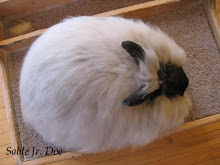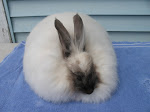The foundation of a bunny of any breed is it's skeletal structure. Even the smallest breeds in the rabbit fancy require excellent bone and mass in order to fill out what type they have completely and properly. Without good bone and a solid skeleton a rabbit will not be in vigorous health, and it will not have the ability to pass inherent strength onto future generations.
After good bone comes comes good type, which can mean many different things depending on what category the breed belongs to. Any rabbit, whether it is commercial, compact, arched, or cylindrical must fill out it's type and be well-fleshed out. Sometimes meat condition is a matter of conditioning and sometimes it is genetic, but good genes play a large part in the ability of any rabbit to flesh out. A genetically disadvanted animal is much less able to reach it's potential regardless of what it is fed or how it is cared for.
Good type is important in every breed (even the wool breeds), because a poorly typed rabbit will be prone to health problems, and an angora cannot carry it's coat properly if it is flat on top or low over the shoulders, etc. A wool coat can part in places where it shouldn't as a result of poor type, and it can lose the oval/rounded effect that is so important to the French and Satin breeds, and to the English and Giant breeds as well which also rely heavily on an even, 'high' shape.
After a good foundation of bone and type, wool or fur can be considered, followed by color. Of course, incorrect color can get a rabbit disqualified immediately, but of all the traits a rabbit possesses, color is more or less the easiest to fix unless a particularly difficult gene is present. The usual consensus among breeders is that type and bone are the most difficult traits to fix, followed by wool/fur, followed by color. For this reason, a good breeding program should focus on the skeleton (foundation) first, followed by the wool (siding), and finally color (of the house:)). Once the biggest characteristics have been taken care of, you can begin to focus on nitty gritty details such as increased wool yield, richness of color, and overall balance of the coat, etc. Building a herd is a long process at best but it goes much more quickly when a long term plan is in place, and it helps when a plan can be compared to something rational and sensible such as building a house from the ground up:).
More stuff next week (and hopefully some baby pictures), but first here are several pictures that I shot a few days ago of 2 different things. One is a little doe out of Sadako's last litter that I will hopefully be adding to my herd over the summer (if all goes well with her first Sr. coat), and the other is a sight for sore rabbit breeders' eyes everywhere-----a FIELD OF DANDELIONS in the spring!!! I was so happy to see these beautiful little things the other day that I took a picture of the most populated spot in my yard immediately. Finally the herd can go back to a nice supplementary diet of greens several days a week in addition to everything else, and I am sure they will have no problem with this whatsoever:0).
This is my little 4 1/2 month old doe (who will be named 'Kitka' if I keep her):

And this is the luscious field of weeds that will be providing untold joy and nourishment to zillions of bunnies here before this summer is through.

























No comments:
Post a Comment